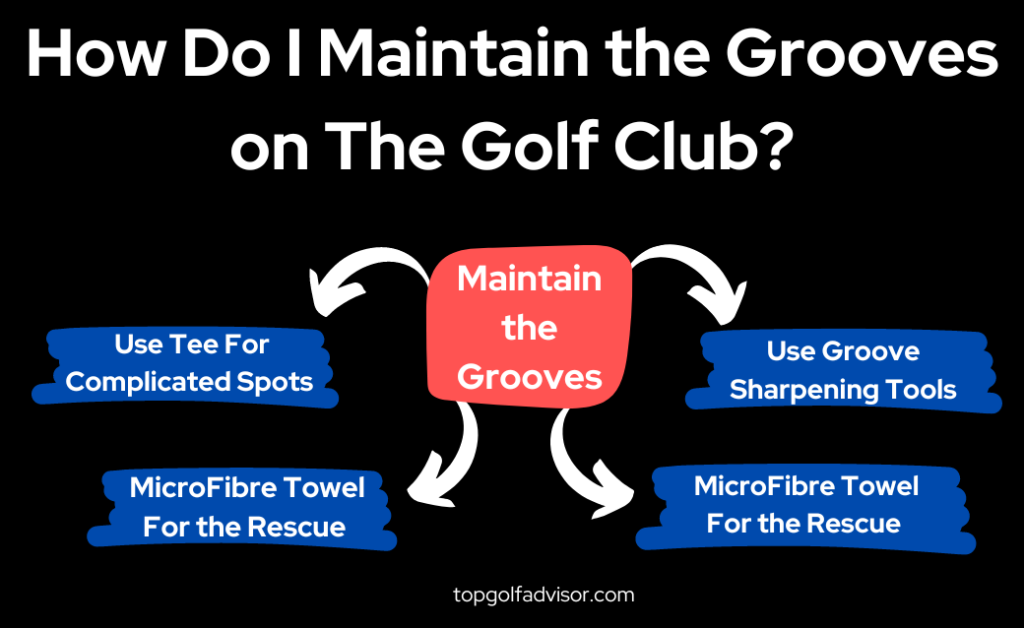As golf enthusiasts, we can never get tired of figuring out new terms for golfing. For example, In today’s blog, we’ll introduce you to grooves in golf clubs. Never heard of it? Don’t worry, we didn’t know either, but a little digging goes a long way.
If you’re a beginner or an intermediate player, it’s better to understand these things beforehand. So, you look well-educated about the sport in front of experienced players. The point is sometimes minor adjustments play a big hand in the overall performance of a golf club.
Therefore, we’re focusing on discussing grooves today, their importance, and their role in the golf club fiasco. So, without wasting more time, let’s get into the details.
What Are Grooves In Golf Clubs?

They provide spin, which, to put it simply, produces drag and lift force for the golf ball. Grooves are one of the crucial factors because they help the ball maintain a controlled flight, which requires a specific amount of spin and speed.
These are important for clubs with wedges rather than drivers because the more loft there is on the club, the more groove you’ll need.
Golfers can acquire reverse spin and control of their shots thanks to the parallel lines on the face of golf clubs known as golf club grooves.
A more vital link between the ball and the club is made possible by the grooves, which enable water and debris to travel away from the contact zone.
Different groove designs and loft-specific grooves are available from some manufacturers of golf clubs. Depending on the particular loft of the wedges, these would alter and grow more complex.
Why Do Golf Club Need Grooves?
Grooves in golf clubs help keep the ball in control. Most golfers believe there wouldn’t be any spin when they play a shot if the ball didn’t have grooves. Surprisingly, the club would spin more if it didn’t have grooves.
But because of how high it would spin, the ball would lose control of the shot and travel incredibly high.
Nonetheless, it would be best to have grooves on your golf clubs even though they are unnecessary. You can play the course with greater precision if you can learn to be wise about keeping your grooves clean and well-maintained.
What Are The Types of Golf Grooves?
You can generally find several types of grooves on a golf club. Most of them depend on the club type and preference. Moreover, you’ll see brands endorsing new groove patterns on their wedge. I know that spin-milled grooves and groove-in-groove technology instantly come to mind as advancements in groove technology.
The U and V grooves, however, are the two most common styles of golf grooves.
Grooves In Golf Clubs (U Grooves)
The groove impact on golfers is a big deal regarding PGA and USGA. They closely monitor the groove technology and what it brings to the table. With the right grooves on the club, your performance can significantly improve when hitting out of the rough.
Golf’s regulatory organizations intend to prevent performance gains from becoming an issue or an unfair advantage. The depth and shape of the groove can affect how well golfers perform.
U-shaped grooves resemble the letter U in that they are shallower and have a rounded edge. The U grooves enable more debris to travel away from impact, even though it may not appear like it.
Due to how excellent they were, the U grooves raised some debate. Even after hitting from a tight lie, professional golfers had no trouble halting the ball on the greens.
They credited the performance and sculpting of the U groove with their success. The width of the U grooves is now subject to tight controls.
V Grooves in Golf Clubs
In contrast to U Grooves, there exist V Grooves. The point of many of these can be a little deeper, but the borders of the groove are sharper. The V grooves are excellent from a straight fairway lay, but they are not considered applicable from the rough.
To design wedges with functional grooves and maintain the integrity of the game for all players, golf manufacturers must adhere to the rules established by the USGA and the PGA Tour.
How Would a Wedge Without any Grooves Perform?
The performance of a wedge golf club would be inferior to one with grooves. Golf balls need spin to be controlled in trajectory and to stop on greens. Hence the grooves on a wedge’s face are made to aid in this process.
The grooves on the clubface of a wedge that hits a golf ball serve to hold the ball and generate friction within the ball and the clubface.
The clubhead’s friction, speed, and loft all work together to give the ball spin. With this spin, the ball can rise rapidly into the air before suddenly stopping on the green.
An ungrooved wedge golf club would not perform as effectively as one with grooves. Golf ball spin, essential for regulating the trajectory and stopping the ball on the green, can be produced with grooves on the face of a wedge.
The grooves in the Golf club’s face of the wedge aid in holding the golf ball and generate friction when the club strikes the ball. The speed and loft of the club head, along with this friction, cause the ball to spin. Thanks to this spin, the ball can ascend quickly into the air before coming to a sudden stop when it strikes the green.
How Do I Maintain the Grooves on The Golf Club?
It’s crucial to keep your golf club’s grooves clean. You won’t get comparable effectiveness from your clubs if the grooves are clogged with junk.
Here are a few techniques to keep grooves in top condition. Although other golfers may have different views on sharpening, you must make your own choice.

Use Tee For Complicated Spots
A golf tee can occasionally remove debris and grime from a clubface. Though it may seem like a straightforward fix, it works.
It’s a smart move if you hit your shot from a muddy lay or even from a bunker shot where sand has accumulated. The tee typically enters the grooves and aids in the dirt’s removal.
To make sure all of the dirt is removed, wipe the club head with a moist towel after using a tee to remove it.
Use Groove Sharpening Tools
To preserve their grooves in good condition, some golfers employ groove-sharpening equipment. The groove sharpeners descend into the groove and restore them to its initial condition.
The better groove sharpening tools on the market are practical, but you must use them carefully. While these tools are acceptable, you cannot change the grooves’ depth or shape.
With these new quality faces, it can sometimes be challenging to determine precisely how you’re sharpening the grooves, and you risk damaging them. You could also experience rusting of your golf clubs if you don’t correctly sharpen.
MicroFibre Towel For the Rescue
Wiping your golf clubs down with a moist microfiber towel is the best way to keep them clean. The straightforward golf towel works the best out of all the rushes, rags, and cleansers I’ve used over the year.
It sometimes takes a little bit of muscle to get the grooves clean, but you will never have to worry about damage. The only thing to remember here is that if you stay more frequent with the cleaning of the grooves, you will have better results.
Conclusion:
Nonetheless, we hope this blog helped clear the air about grooves in golf clubs. Golf clubs must have grooves because they significantly impact a golfer’s game. They produce backspin and aid in ball flight management, making it simpler to hit precise shots from various lies and circumstances.
To perform at their best on the course, golfers must pay close attention to the grooves on their clubs and make sure they are in good condition. Grooves may help golfers of all skill levels play their best and enjoy the game entirely with the proper care and attention to precision.
Moreover, you can check out other blogs such as what are preferred lies in golf and many more related articles to expand your knowledge about the sport.
FAQs
Do you need to keep grooves clean?
Clean grooves are essential since they lower the likelihood of flyers. A flyer 7-iron might amaze your friends, but you’ll likely be left with a terrible chip to try and save par. According to research, if you don’t maintain the cleanliness of your grooves, you could lose up to 1,300 RPM of spin.
When do you know if your grooves are worn out?
Look out for flyers. The grooves may wear if you observe the ball flying higher and farther.
Also Read:
Can Men Use Womens Golf Clubs | Guide 2023
